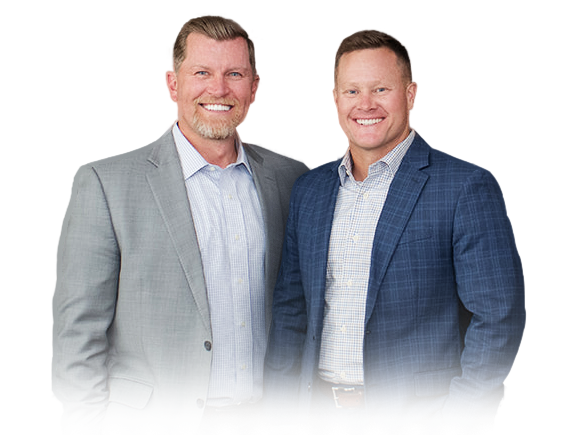 The State Farm car accident settlement process in Utah creates many challenges for crash victims seeking fair compensation. At Good Guys Injury Law, our personal injury lawyers fight State Farm’s tactics every day. As Utah’s biggest car insurance company, State Farm covers about 19% of drivers in our state, making them a common opponent in car accident cases.
The State Farm car accident settlement process in Utah creates many challenges for crash victims seeking fair compensation. At Good Guys Injury Law, our personal injury lawyers fight State Farm’s tactics every day. As Utah’s biggest car insurance company, State Farm covers about 19% of drivers in our state, making them a common opponent in car accident cases.
We know how hard it is to deal with this big insurance company while trying to heal from injuries. Our law firm has handled hundreds of State Farm claims and knows what it takes to get you fair compensation. Let’s look at what happens when you face State Farm after a car accident in Utah.
Table of Contents
Understanding the State Farm Car Accident Settlement Process in Utah
Getting fair payment after a car crash with State Farm insurance in Utah can be hard. Many victims feel lost in paperwork and pressured to make quick settlements. Learning how State Farm works in our state is your first step to getting the money you truly deserve.
How State Farm Handles Auto Claims in Utah
State Farm handles claims differently from other insurance companies in Utah. While they advertise through local agents, these agents rarely help with claims. Instead, your auto claim goes to large claims centers where insurance adjusters follow strict guidelines.
State Farm uses lots of resources to pay out as little as possible. Their claims departments have teams of adjusters, investigators, and in-house attorneys trained to protect company profits. When you know this setup, you can better prepare for the tactics they’ll use during your insurance claim.
Common Challenges with State Farm Settlements
The biggest problems our clients face with State Farm claims include very low initial offers and long delays. One recent client came to us after State Farm’s settlement offer was just $5,000 for injuries that needed $18,000 in medical expenses. This pattern of undervaluing claims is something we see often with this insurance carrier.
State Farm also asks for too much paperwork and asks questions about whether your medical treatment is needed. They often cite “pre-existing conditions” to deny full payment, even when the accident clearly aggravated those conditions. With good legal help, these roadblocks can be overcome through smart negotiation and, when needed, filing suit.
Dealing with the Insurance Company After a Car Accident
 After a car crash, how you talk with State Farm will greatly affect the outcome of your claim. Many accident victims don’t realize that insurance companies focus on making money, not on their recovery. Being ready for this fact helps you avoid mistakes that could hurt your right to fair payment.
After a car crash, how you talk with State Farm will greatly affect the outcome of your claim. Many accident victims don’t realize that insurance companies focus on making money, not on their recovery. Being ready for this fact helps you avoid mistakes that could hurt your right to fair payment.
Why State Farm Adjusters May Undervalue Your Claim
State Farm insurance adjusters often operate under policies that incentivize quick, low-value settlements. New adjusters usually can only offer $5,000-$10,000 at most, no matter what your claim is really worth. This limit explains why first offers rarely match the true claim value.
The adjusters handling pre-lawsuit claims are very different from those who take over once you file suit. Pre-lawsuit adjusters focus on quick, low settlements, while litigation adjusters have more power and often see claim values more fairly. This change explains why filing a suit often leads to much better offers, sometimes two or three times the first amount.
How State Farm’s TEACH Software Impacts Settlements
State Farm relies on computer software called TEACH to calculate settlement values. This program looks at injury types, treatment patterns, and medical costs using preset rules that often miss your unique situation.
TEACH typically reduces medical expenses it deems ‘too high,’ relying on averages rather than your specific circumstances. The system struggles to properly value pain and suffering damages properly, often using rigid formulas instead of considering how injuries truly affect your life. Personal injury attorneys who know this software can present your case in ways that fight these computer-based limits.
The Insurance Claim Process with State Farm
Filing an insurance claim with State Farm needs careful attention. The steps you take early on can either strengthen your position or create problems that may be hard to fix later. Our experience handling State Farm claims has helped us develop smart approaches to the claims process.
Steps to File a Claim After a Car Accident
To start your claim with State Farm, report the car accident quickly—ideally within 24 hours. Utah law gives you up to 3 years to file a personal injury claim, but delays can hurt your case. You can file a claim online, through the State Farm mobile app, by calling their claims hotline, or through your local agent.
Be ready to provide basic accident information, including:
- Date, time, and location
- All people involved
- Your policy number
- Police report information
- Photos of damages
While you must report the accident, be careful not to give recorded statements without legal advice. Never speculate who the at-fault driver was or downplay your injuries during the first talks.
How State Farm Evaluates Injury Claims
State Farm looks at several key factors when reviewing bodily injury claims:
- Clear proof of who was at fault
- Well-documented past medical expenses and future medical expenses
- Proof that injuries came directly from the accident
Medical records form the foundation of your claim’s value, making thorough documentation crucial. Third-party claims against at-fault drivers with State Farm insurance coverage require even more careful documentation.
Utah follows a modified comparative negligence system, meaning your percentage of fault may reduce your payment. If you’re found more than 50% responsible, you could lose your right to recover damages. State Farm uses this law aggressively to pay less, often trying to shift blame to injured parties. Having strong evidence and legal representation helps fight unfair-fault decisions.
What to Do After a Car Accident in Utah
 The moments after a car accident are critical for both your health and your future insurance claim. What you do right after the crash can make the difference between a strong claim and one that State Farm can easily dispute. Being prepared helps protect your interests from the start.
The moments after a car accident are critical for both your health and your future insurance claim. What you do right after the crash can make the difference between a strong claim and one that State Farm can easily dispute. Being prepared helps protect your interests from the start.
Gathering Evidence at the Accident Scene
Collect as much evidence as possible at the accident scene if you’re able to. Take photos of all vehicles from multiple angles, including:
- Areas of damage
- License plates
- The overall accident scene
- Road conditions
- Traffic signals
- Any skid marks or debris
Exchange information with other drivers, including names, contact details, insurance policy information, and vehicle details. Get contact information from witnesses, as their statements can be very valuable if liability is disputed. Use your smartphone to record notes describing the accident while your memory is fresh.
Reporting the Accident to State Farm
Contact State Farm within 24 hours by calling their claims department or using their mobile app. Provide only the basic facts: date, time, location, vehicles involved, and injuries that occurred. Avoid detailed discussions about fault or your injuries in this initial report.
Be careful when speaking with State Farm representatives, as they may ask questions designed to reduce their liability. Never say “I’m fine” or “It was partly my fault” during these conversations. Utah requires accidents resulting in injuries or more than $1,500 in property damage to be reported to the police, so make sure you’ve met this legal duty before contacting State Farm.
The Claims Process: From Filing to Settlement
The journey from filing your claim to getting a fair settlement involves many stages. Understanding how State Farm approaches this process helps you make smart choices about when to accept offers and when to push for more. Our experience with State Farm claims gives us insight into the patterns that typically emerge during settlement negotiations.
State Farm’s approach to claims follows a pattern designed to minimize payouts. From initial investigation through settlement negotiations, each step presents chances to either strengthen or weaken your position. Knowing what to expect helps you avoid common traps.
State Farm’s Initial Settlement Offers & Negotiations
After looking into your claim, State Farm typically makes an initial settlement offer within 30-60 days. These first offers often range from 30-40% below your claim’s actual value. For example, a claim worth $50,000 might receive a first offer of just $20,000-$30,000, regardless of your medical expenses or suffering.
Data from our past cases shows that State Farm’s final settlements average 2.5 times their initial offers. This gap comes from their strategic approach to negotiations, testing to see if you’ll accept less than you deserve. When negotiating with State Farm, we recommend waiting until you’ve reached maximum medical improvement before discussing settlement figures. This gives a complete picture of your medical needs and stops you from settling for too little.
Early settlement talks should focus on showing clear liability and documenting all damages. We’ve found that organizing medical records in order, with treatment costs clearly linked to accident-related injuries, creates pressure for better offers.
When to Escalate Your Claim to Litigation
If State Farm refuses to make a reasonable settlement offer after several rounds of talks, filing suit becomes necessary. Clear signs include:
- Offers that fail to cover your medical expenses
- Repeated delays
- Denials based on questionable fault decisions
Filing a lawsuit dramatically changes how State Farm handles your claim. Your case gets reassigned to a litigation adjuster with higher settlement authority, and State Farm’s in-house attorneys become involved. This shift often triggers big increases in settlement offers—we’ve seen offers double within weeks of filing suit.
The closer your case gets to trial, the more likely State Farm becomes to make fair offers. As the trial date nears, the company’s risk assessment changes, especially if your case is strong and well-documented. Our firm prepares every case as if it will go to trial, which gives us a stronger position throughout the process. In many cases, State Farm eventually settled just before the trial date for much more than its initial offer.
Protecting the Rights of Accident Victims in Utah
 Accident victims face special challenges when dealing with State Farm’s claims-handling practices. The company uses different strategies based on claim size and type, making it essential to understand their approach to your specific situation. Our focus remains on getting fair compensation for injured people regardless of claim size.
Accident victims face special challenges when dealing with State Farm’s claims-handling practices. The company uses different strategies based on claim size and type, making it essential to understand their approach to your specific situation. Our focus remains on getting fair compensation for injured people regardless of claim size.
The insurance industry operates with clear profit goals that often conflict with fair treatment of accident victims. State Farm, as a leader in this industry, has developed complex methods to minimize payouts that can leave injured people without the resources they need for recovery. We’ve studied these methods to develop effective countermeasures.
How State Farm Treats Small vs. Large Claims
State Farm handles small claims (typically under $10,000) very differently than larger ones. Small claims get processed by teams of State Farm adjusters rather than individuals, with a focus on quick, minimal settlements. These teams have extremely limited settlement authority and often take aggressive positions on minor injuries.
Larger claims receive more individual attention but face intense scrutiny. State Farm frequently hires investigators to conduct surveillance and medical experts to question alleged injuries or treatment necessity for significant claims. Despite these differences, we believe every claim deserves thorough representation. We’ve helped clients with “small” claims receive proper compensation that was initially denied, sometimes turning $5,000 offers into $25,000 settlements through persistent advocacy.
Why State Farm Often Takes Cases to Trial
Unlike many other insurance companies that avoid courtrooms, State Farm has a reputation for taking cases to trial. Their willingness to litigate stems from a corporate philosophy that fighting some claims discourages others. State Farm takes approximately 15% more cases to trial than other insurance companies in the industry.
This trial-ready approach means they’re less likely to make last-minute settlement offers out of fear of juries. Instead, they carefully assess risks and stand firm on their valuation if they believe they can win. Our firm counters this strategy by preparing comprehensive trial presentations from day one, showing State Farm we’re equally ready for court. When they see our preparation level, settlement discussions often become more productive.
Fighting for a Fair Injury Claim Against State Farm
Getting fair payment from State Farm requires understanding how they value claims and developing targeted strategies to overcome their tactics. Our approach combines deep knowledge of their practices with customized advocacy for each client’s specific situation. This combination has helped us succeed in numerous personal injury cases where the plaintiff’s lawyer made all the difference.
Battling for fair treatment from State Farm involves much more than simple negotiations. It requires a detailed understanding of their internal processes, documentation requirements, and settlement criteria. State Farm accident attorneys have developed specialized approaches based on years of experience with this particular insurance carrier.
How State Farm Calculates Pain & Suffering
State Farm typically uses a formula approach to calculate pain and suffering damages. For minor to moderate injuries, they often apply a multiplier between 1 and 3 times your medical expenses. This formula fails to capture the full effects of injuries on your life, particularly for injuries causing long-term limitations.
Medical documentation significantly affects these calculations. Detailed notes from doctors about pain levels, activity restrictions, and emotional repercussions can justify higher valuations. We encourage clients to:
- Keep pain journals
- Ensure medical visits properly document all symptoms
- Get detailed reports for major injuries
- Follow all prescribed medical care
- Document how injuries affect daily activities
When State Farm’s calculations seem unfair, we counter with comprehensive evidence that goes beyond simple formulas, presenting the full picture of how injuries have affected your daily activities, work, and relationships.
Strategies to Counter Lowball Settlement Offers
The most effective tactic against State Farm’s lowball offers is thorough preparation with compelling evidence. This includes complete medical records, expert testimony on future medical needs, and clear evidence linking all injuries to the accident. Properly presented evidence leaves State Farm with fewer opportunities to minimize your claim.
Expert witnesses play crucial roles in challenging State Farm’s valuations. Medical experts can establish the necessity of treatments that State Farm questions, while economic experts can document lost wages and future losses from injuries. We’ve seen settlement offers increase by 35-40% after introducing expert opinions on disputed medical issues.
Having experienced personal injury lawyers levels the playing field with State Farm. Their adjusters treat represented claimants differently, knowing attorneys understand fair claim values and litigation processes. Our familiarity with State Farm’s tactics allows us to anticipate their moves and prepare effective responses, turning their standard practices into leverage for better settlements. In many cases where our lawyers pursued aggressive strategies, State Farm paid significantly more than their initial offers.
Contact Our Car Accident Lawyer for a Free Case Evaluation
 If you’re struggling with a State Farm car accident claim in Utah, our team at Good Guys Injury Law is ready to help. We’ve handled hundreds of State Farm claims and know exactly how to counter their tactics. Our track record includes numerous cases where we’ve secured fair compensation several times larger than State Farm’s initial offers.
If you’re struggling with a State Farm car accident claim in Utah, our team at Good Guys Injury Law is ready to help. We’ve handled hundreds of State Farm claims and know exactly how to counter their tactics. Our track record includes numerous cases where we’ve secured fair compensation several times larger than State Farm’s initial offers.
We help clients get money for all types of damages, including past and future medical expenses, lost wages, pain and suffering, and property damage, including finding a trusted repair shop. It also includes personal injury protection benefits.
Our law firm offers a free case evaluation to review your situation and explain your options with no obligation. We can provide a realistic assessment of your claim’s value and whether it might exceed policy limits. We work on a contingency fee basis, meaning you pay nothing unless we win compensation for you. Don’t face State Farm alone. Contact us today for a free consultation. We can even help with guaranteed completion dates for property damage claims while fighting for your personal injury claim.






